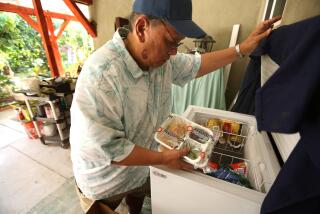L.A. Activists Denounce Welfare Check Proposal
- Share via
A plan by Los Angeles County to change its system of distributing welfare checks is drawing protest from community groups, businesses and property owners who contend that it will disrupt the economic stability of entire neighborhoods.
The new arrangement is a portent of the sweeping restructuring of virtually all aspects of public assistance in California and across the nation, generated by the welfare legislation signed in August by President Clinton.
The overhaul means an inevitable tide of change, nearly everyone agrees. But community leaders fear that little heed will be paid to the needs of welfare recipients as the federal law filters down to local neighborhoods, and they point to the county’s new distribution plan as justifying their concerns.
As a result of the new system devised by the county Department of Public Social Services and scheduled to begin Feb. 1, Aid to Families With Dependent Children checks for more than 300,000 recipients would no longer be mailed on the first of the month, but staggered over the first 10 days of each month.
In the second phase of the plan, to begin in June, mail delivery of the checks would cease, except to the elderly and disabled and in certain other hardship cases. Most recipients would be required to pick up their checks at a few dozen designated outlets scattered around the county.
Opponents say the staggered mailing of checks would wreak havoc on landlords and tenants. Welfare recipients could be subject to late fees and eviction for not paying their rent on time. Apartment owners, saying they could not legally grant rent extensions to some tenants without giving them to all, fear they might miss mortgage payments and face economic ruin.
Critics also say the plan to distribute AFDC checks at sites already designated as food stamp outlets would exacerbate problems of overcrowding, long lines and poor service, not to mention handing the few designated businesses a monopoly on a range of services currently bestowed on numerous neighborhood stores.
“They don’t seem to be aware of what is going on in these communities, the kinds of things people have to go through,” said the Rev. Romie J. Lilly II, chairman of the Community Alliance for Stability and Healthy Economics. “And they don’t seem to realize the impact to local business. If a person can get a check mailed to them at home, they are going to cash it around the community and buy around the community. If they have to go two miles away to get a check at a check-cashing business, they likely will cash it there. Many people on welfare may already live in communities with marginal economic stability and if you take what little money there is away, it’s going to have a negative impact.”
Other critics question why the county would initiate such a sweeping change with no formal survey or analysis of the likely costs versus benefits. They want the County Board of Supervisors to address the issue so that there can be public input.
“From a business perspective, you sit down, look at the problem, figure out the remedy and then announce the solution,” said Nancy Ahlswede, executive vice president of the California Southern Cities Apartment Assn., an industry group. “The way they seem to be going about it is to announce the solution before anything else.”
*
Los Angeles County would be the first in the state to eliminate mail delivery of AFDC grants and the new system still awaits formal state approval--although it is expected to be granted shortly, said Nancy Bell, a spokeswoman for the state Department of Social Services. County officials say they are responding in part to concerns of postal authorities, who believe the new system will help stem an ongoing problem of mail thefts. In fiscal year 1994-95, 107 letter carriers were robbed in Los Angeles County, according to officials with the Postal Inspection Service.
“Whenever a letter carrier is robbed in a district, we stop delivering mail to everyone in that district,” said postal inspector Pamela Prince. “The people I have spoken with are greatly looking forward to the day when they don’t have to deliver these checks in the mail.”
After an intensive safety campaign, the number of robberies dropped to 37 last year, Prince said, but postal authorities are still anxious for the county to implement the new plan.
The county is also being pressured by its banking partners, who have indicated that they no longer want to handle the walk-in business of hundreds of thousands of welfare recipients.
Wells Fargo--which inherited one of the county’s biggest banking contracts from First Interstate Bank last year--has complained of long lines clogging the lobbies of its branch offices on the first of the month when welfare checks historically have been mailed.
Bank officials have told the county that they will not renew the agreement--which includes a range of other financial services-- when it expires in June, said County Treasurer and Tax Collector Larry J. Monteilh. The county is in negotiations with Bank of America to provide financial services, but that bank does not want the welfare business either, acknowledged Monteilh.
Lynn W. Bayer, director of the county Department of Public Social Services, conceded that pressure from postal and banking authorities is driving the county to move quickly to implement changes. But she argued that the moves would also benefit some 4,000 to 5,000 recipients each month whose checks are undeliverable because of changes of address or other reasons.
Bayer also noted that the county plans to exempt any welfare recipient who can prove a hardship, including those who face eviction. The county has sent out fliers urging landlords to accommodate the changes.
The disabled and elderly would continue to receive checks in the mail, as would those living in remote areas, such as Santa Catalina Island and Gorman. And the nearly 4,000 recipients living in public housing projects would also continue to receive checks on the first of the month, said Sandy Semtner, chief of the department’s administrative services branch.
Finally, Bayer said, the new system reflects the coming tide of welfare reform that ends 60 years of guaranteed cash assistance to the poor under the AFDC program and transfers most authority for running welfare programs to the states.
The federal plan, for example, calls for states to install an electronic transfer system that would deposit government checks for recipients into an account. The recipients would be issued ATM-like benefits cards that they could use to debit purchases. This new system is required to be online by 2002. State authorities have asked Los Angeles County if they can get a system up by 2000, Bayer said.
Bayer said the county is trying to soften the blows of some of the changes. Officials are trying to determine if the 10-day mailing period can be reduced to possibly five days. And the county would allow more businesses that meet qualifications to become outlets.
There are currently 44 designated outlets at which AFDC recipients are required to pick up food stamps and from which the county’s 90,000 general relief recipients must retrieve their benefit checks. Two companies operate about 20 of the outlets, while 14 other companies operate one or more outlets.
Bayer said the county has not determined how many outlets would be sufficient to meet the new demands. But she said the food stamp and general relief distribution, which is also staggered over 10 days, has worked well.
Thomas Nix, whose firm operates 80 check cashing facilities in the county, has been leading much of the business opposition to the county distribution plan. He said the county’s efforts to narrow the mailing period and to increase the number of outlets are positive steps.
“Nothing is in concrete yet, but I’m delighted that the county has been so responsive,” said Nix, whose company operates two designated outlets. “There is still going to be some economic impact . . . but I think you avoid most of the negatives associated with the plan.”
But other opponents disagree. Ahlswede said that distributing checks over a five-day period would be better than a 10-day period but would not eliminate potential landlord-tenant frictions.
And she doubts the county will be able to identify and approve new outlets before June.
“The process of laying out criteria, sending out a [request for proposal], identifying possible applicants and approving them takes at least six to nine months,” she said. “Our position is if the county agrees that 44 are not enough, let’s not start this program until the new ones are up and running.”
The new plan would exacerbate intolerable conditions that welfare recipients already must endure, said Stella Payton, a young mother who spent nearly three years on welfare before starting her own job and skills training business.
Payton, part of a community coalition opposed to the changes, said she encountered waits of two and three hours to pick up her food stamps in county-contracted outlets that were dirty and lacked restrooms and sufficient security.
“You have to go and stand in lines that begin around the block, and you have your children with you, and the baby is shifting around, and don’t let it be raining or a cold day or a really hot day,” she said. “A lot of times the computer would go down for two or three hours and if you came on the bus, then you’d have to take the bus back home and come another day. But with AFDC checks, if your rent is due, you have to stay. There has got to be a better way that doesn’t create so much hardship for the recipients.”
More to Read
Sign up for Essential California
The most important California stories and recommendations in your inbox every morning.
You may occasionally receive promotional content from the Los Angeles Times.











